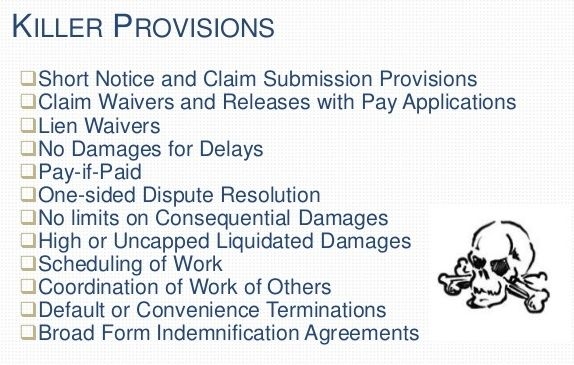Contracts
Contracts are nothing more than written agreements. Two people can decide to do business with each other, orally define the terms and conditions that structure their agreement, spit in their palms, and shake their hands. If both parties trust each other and maintain ethical integrity, the handshake can be more than sufficient. However, if the parties don't trust each other, or either party has trouble maintaining their ethical integrity, the handshake is worthless.
Too many times the handshake has failed to maintain the seal of bond between the parties making an oral agreement. That is why we inscribed contracts upon papyrus.
 There is a saying that a Chicago grand jury could indict a ham sandwich. Likewise, you can write a contract that defines how to make the ham sandwich, how to serve the ham sandwich, and how to eat the ham sandwich. Contracts merely put into writing the terms and conditions the two parties are going to follow in an agreement. Contracts can be simple and straightforward. Contracts can also be complex and confusing.
There is a saying that a Chicago grand jury could indict a ham sandwich. Likewise, you can write a contract that defines how to make the ham sandwich, how to serve the ham sandwich, and how to eat the ham sandwich. Contracts merely put into writing the terms and conditions the two parties are going to follow in an agreement. Contracts can be simple and straightforward. Contracts can also be complex and confusing.
Contracts become long, complex, and confusing the larger, more complex, and more expensive the agreement. Contracts also become long when efforts are made to reduce risk by identifying and defining every potential issue that could appear in the execution of the agreement. Basically, the more money is involved in the deal, the more risk there is for something to go wrong, and the more likely the contract will be large and complex.
Contract packages can grow so expansive that they consume a ream of paper. Contracts are seldom easy to read. In most cases, even a contract that is written in plain English can become confusing as it grows and develops. There is no standard format for most contracts. Like a novel, the quality of the contract depends on the organization and writing skills of the people who draft the document.
Prime & Sub
In a perfect world, the relationship between a Prime Contractor and its Subcontractors is built on a foundation of mutual trust, clear communications, sufficient leadership, clear roles and responsibilities, and the ethical concept of fair dealing. It only makes sense that all these qualities must exist in the relationship, and as such should be part of the structure of the contract.
However, you will find few contracts that define clear communications, what constitutes sufficient leadership by the prime contractor, or the clear roles and responsibilities of the parties, and few of them even address the topic of fair dealing. There is an expectation by many people that contracts are fair and just. Contracts can be fair and just if the parties drafting the contract choose to make them that way. But even with a balanced and fair contract, the parties may still choose not to behave in a balanced and fair manner.
Since we don't live in a perfect world, companies rely on contracts and the law to define expected behavior in a relationship. Look at any contract and identify where the agreement stipulates that the parties must act with mutual trust, that the parties must engage in clear communications, that leadership is expected, or that there is an expectation of fair dealing.
Here are some examples of language out of actual agreements. How do you think this language helps ensure mutual trust and fair dealing?
- Contract Documents:
“The applicable Subcontract Agreement; this Installation Agreement; the Main Contract; and other documents identified therein; and to the extent applicable to the subcontract work, as stated in each Subcontract Agreement; modifications and amendments to the Main Contract, whether before or after the execution of the subcontract; modifications and amendments to the subcontract; and such other contract documents as identified in the subcontract agreement"
- Precedence of terms and conditions:
“In the event of a conflict between one or more provisions of the contract documents, the provision imposing the more demanding term, condition, duty or standard of performance, or the greater limitation on the nature and type of relief or damages allowed to the subcontractor, or providing the greater relief work authority to the contractor, shall control."
- Contract Document Flow:
“the rights and obligations of the subcontractor to the contractor are identical to the rights and obligations of the contractor to its customer. Subcontractor assumes and agrees to perform all the obligations and responsibilities of contractor in relation to the subcontract work and to carry out the same in every respect to the reasonable satisfaction of the contractor. Contractor shall have the benefit of all rights, redress and remedies against the subcontractor which the customer has against the contractor under the main agreement."
- Resolution of Issues:
“Contractor shall decide all questions which may arise as to the interpretation of the contract documents relating to the work, the fulfillment of the contract documents on the part of the subcontractor, and the rights or different subcontractors on the project including, but not limited to, any subcontractor or subcontractors claim that another contractor or subcontractor caused damage in any form."
“Subcontractor agrees to be bound by all interpretations, decisions or other written instructions by the customer, owner, architect, any court, arbitration panel, or other body relative to the question, and interpretation, ambiguity or discrepancy in the contract documents in the same manner as the contractor is bound."
I know, this is not thrilling reading. Imagine that you are a Subcontractor, and the Prime Contractor just handed you a blanket services agreement for you to sign that contains the four contractual terms outlined above. How comfortable are you as a Subcontractor agreeing to these terms? Do you, in reading those conditions, see a logical reason for the terms? Or are you thinking it is unlikely that these clauses will come into play?
If you don't understand what these clauses mean, or are thinking that they will not be important, you need a translation. So, let us translate:
- The number of documents that can affect this agreement is endless. The subcontractor is not only agreeing to documents outside of this agreement, but is also agreeing to be bound to modifications that have not yet happened. What happens if there is a change in another set of documents, referenced by this contract, that violates either the ethical beliefs of the Subcontractor or the statutory laws that the Subcontractor must abide by?
- By agreeing to this, the Subcontractor agrees that when there is a conflict of terms, the terms that are least helpful to the Subcontractor and most helpful to the contractor prevail. In other words, when in doubt, screw the Subcontractor.
- The Subcontractor is now bound to the exact same terms as the Prime Contractor. If the Prime Contractor agrees to 90-day payment terms, the Subcontractor now agrees to 90-day payment terms. If the Contractor agrees to a union labor job after the Subcontractor agreed to the work, the Subcontractor will have to provide union labor. Combined with the first point, if the Prime Contractor agrees to modification that changes payment terms, the Subcontractor must live with those same terms.
- Finally, if there is a difference in interpretation between the Contractor and the Subcontractor, the prime contractor wins. If the Prime Contractor wishes to enforce the agreement tightly, they can. If the Prime Contractor decides to interpret the contract in a way that is detrimental to the Subcontractor, they have every right to do so.
If you think these terms and conditions are one-sided, you win a gold star. If you think these terms and conditions are fair or are rare and not found in very many contracts, you are being naïve.

He who writes the paper controls the contract, and these examples illustrate the heavy-handed way many Prime Contractors choose to develop contractual relationships with their Subcontractors. When your company does not write the contract, you should expect the other side to know the contract far better than you do. Prime Contractors put these clauses in contracts because they intend to use them.
 These are only a few of the 50 Shades of Gray in contractual business relationships. As water runs downhill, so do contracts. Prime Contractors are often sophisticated organizations that force less sophisticated Subcontractors into subservient positions with their contract language. Prime Contractors have legal teams on staff, and outside counsel at the ready to help enforce the terms of the contract, the cost passed to the Subcontractor as stipulated in the same contract. If a Subcontractor thinks that they will get to negotiate these undesired terms away after they sign the agreement, they are being wishfully foolish.
These are only a few of the 50 Shades of Gray in contractual business relationships. As water runs downhill, so do contracts. Prime Contractors are often sophisticated organizations that force less sophisticated Subcontractors into subservient positions with their contract language. Prime Contractors have legal teams on staff, and outside counsel at the ready to help enforce the terms of the contract, the cost passed to the Subcontractor as stipulated in the same contract. If a Subcontractor thinks that they will get to negotiate these undesired terms away after they sign the agreement, they are being wishfully foolish.
Do you think that these terms are ethical? They may not be. But they may be legal.
Note:
- In this series, we are replacing company names with their roles. The reader should imagine that there is an actual company behind each title, i.e., Prime Contractor.
- Just as a reminder given the nature of this series, I am a logistician and IANAL (I am not a lawyer).



